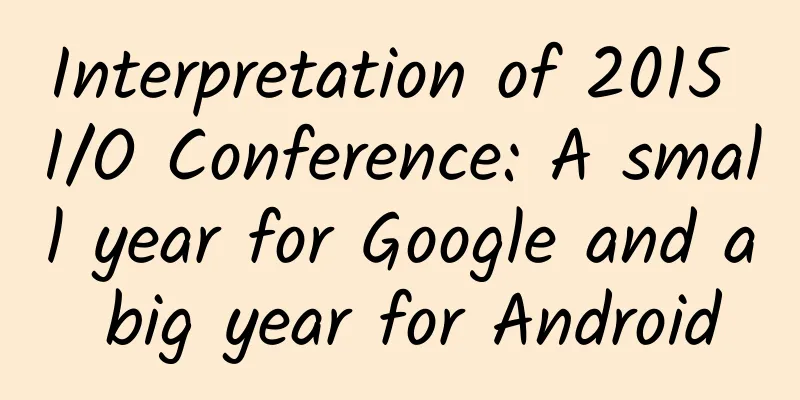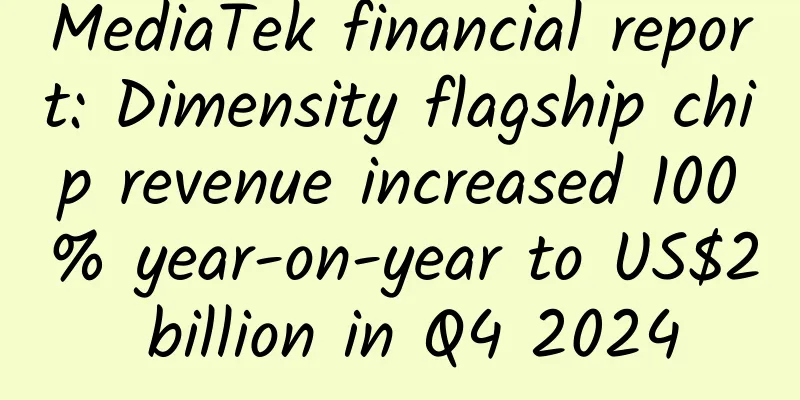Interpretation of 2015 I/O Conference: A small year for Google and a big year for Android

|
The development of technology companies also has its ups and downs, with peaks, flat roads and valleys. Compared with the Google I/O in previous years, this year's conference was indeed a little dull. Everyone is looking forward to a great company releasing a new epoch-making product, just like when Steve Jobs pulled out the Macbook Air from an envelope, just like when Google used helicopter parachuting to release Google Glass in the first person, just like when Microsoft released the high-tech holographic glasses HoloLens this year. But tech giants can’t change the world every year, and Steve Jobs can’t shock the world every time. In addition to those disruptive products that debut in big years, products released in small years may be more related to the actual experience of consumers and the smooth progress of the overall strategy of tech giants. This year’s Google I/O is officially committed to improving the actual experience of the Android platform, continuously improving the humanization and intelligence of current services, and trying to gain an advantage in the competition with Apple and future strategic deployment. Let's take a brief look at the products released at this year's Google I/O: Android M with more complete functions, simpler application permission management, smarter battery life management, the launch of Android Pay, the addition of system fingerprint recognition management, the use of a new data interface Type-C, and embedded links that can directly open related applications; the more intelligent Google Now, which can intelligently learn the user's usage scenarios to predict searches. For example, if a friend mentions a restaurant in a text message, Google Now can directly display the restaurant information; the cross-platform photo management application Google Photos, which provides unlimited storage capacity for free, can intelligently classify photos according to time, place, and people, and supports text search of photo content; the more practical wearable platform Android Wear, which supports practical scenarios such as calling a taxi directly with a watch. In addition, Google also released Brillo, an IoT platform derived from Android, which is connected to mobile phones and the cloud through the Weave dialogue mechanism, has lower hardware requirements and is suitable for various IoT devices; Google Maps supports offline search and navigation, which can save traffic and is suitable for situations without network. At the same time, the Internet giant also introduced the follow-up of projects such as the low-cost simple VR device Carboard, the balloon Wifi network project Project Loon, and driverless cars. It is obvious that this year's Google I/O is more about constantly improving the actual experience of existing platforms, products and services, and improving the intelligence of already excellent products and services through means such as big data search and machine learning. In the words of Sundar Pichai, Google's senior vice president of products, "searching and organizing information is what Google is best at." Perhaps for Google now, rather than taking the risk of launching cutting-edge technology projects with unclear commercial prospects, it is better to continue to improve the user experience of existing products and services, especially the Android platform, the cornerstone of its mobile business. Overall, Google's Android platform is in a good situation, and its leading position is undisputed. According to IDC data, Android accounted for 81.5% of the global smartphone market last year, far higher than the 14.8% of Apple, which ranked second. Android shipped more than 1 billion units throughout the year, with more than 4,000 devices from more than 400 manufacturers and more than 500 operators. But if we look at the market changes after the release of Apple's large-screen iPhone, perhaps Google and Android's high-end manufacturers will feel the pressure. According to IDC data, in the second quarter before Apple released the large-screen iPhone last year, Android's global market share was 85%, but it dropped sharply to 76% in the fourth quarter, while Apple's share soared from 11.7% to 19.7% during the same period. Surprisingly, in the fourth quarter of last year, Apple's shipments actually caught up with Samsung, becoming the first in the global market and the Chinese market for the first time. The sales growth of Android phones comes more from mid- and low-end products, especially the rise of Chinese manufacturers. What is even more embarrassing for Google is that, although it has already released seven Android smart watches, its global sales last year were only about 700,000 units, which is still less than the 1 million pre-orders on the first day of the launch of the Apple Watch this year. (This is not the pre-order volume that is often inflated by domestic mobile phone manufacturers, but the actual payment data.) Why can Apple easily overwhelm Samsung in the high-end market after launching the large-screen iPhone two years after lagging behind the market, and even take the top spot in China, which is not a developed market? Apple's hardware is no longer the advantage that iPhone 4 had over its competitors. In terms of various hardware indicators, Apple is even far behind its Android competitors. Perhaps the biggest reason is that Apple has the moat of iOS. As long as it has 70% hardware, it can surpass 100% Android hardware products in terms of experience. For a long time, Android's advantage in being the mainstream is the large number of hardware manufacturers, multiple models and various price options. The rise of Chinese smartphone manufacturers is based on the huge Chinese market and the strategy of low price and high configuration. In addition to the brand value advantage, the iPhone's greater advantage lies in the iOS platform. The iOS platform left by Jobs has the inherent advantages of being closed and single-threaded but with a better user experience. The battery capacity of the iPhone is much lower than that of the Android flagship of the same level, and is even only half of the latter, but there is no huge gap in battery life. Improve Android application authorization, save platform power consumption, integrate fingerprint recognition, add mobile payment services; yes, the Android M platform released by Google today is based on the original defects and continuously improves, making Android phones smoother, safer, and more power-saving, trying to narrow the gap with iOS at the system level, thereby improving the competitiveness of hardware products. In fact, Google has been working hard to improve the inherent problems of Android in the past two years. Switching to ART mode in Android 4.4 has significantly improved the system's lag problem. In this sense, this year's weak year of Google I/O may have a more important significance, because improving the actual experience of Android compared to iOS can lay a solid foundation for the future of the Android platform and help Android manufacturers regain the lost ground in the high-end market that was easily taken away by Apple's large-screen iPhone. On the other hand, this year Google also launched offline-supported Google Maps, the more user-friendly Google Now, and the cross-platform photo application Google Photos. These cross-platform services are Google's traditional advantages. Even though Apple's mobile phone sales have soared, Google is still the most popular software and cloud service provider on the Apple platform. No other manufacturer can challenge this advantage. Google alone occupies five of the top ten popular mobile applications in the United States. It is worth mentioning that Google Photos is free and unlimited across platforms, which is exactly the impact of Gmail back then. When the mailbox capacity of Yahoo and Microsoft was still a few MB, Google launched the free Gmail service with 1GB storage on April Fool's Day, which shocked the entire mailbox industry. Today's Google Photos is exactly the same logic, with better functions, more cross-platform, completely free and no storage capacity limit. This new application will undoubtedly impact the current personal cloud storage service, affecting many industry competitors such as Apple iCloud, Dropbox, Microsoft OneDrive, etc. The Internet of Things represented by smart homes is obviously a hot spot for competition in the future. Many giants such as Apple, Intel, and Qualcomm have already deployed them. The same is true for Brillo, the Internet of Things platform released by Google this year. With 1 billion users and a large number of cooperative manufacturers, Google is likely to have the same market share as Android in the field of smart homes and the Internet of Things in the future, because smartphones are the control center of this emerging field. The simple and clean VR device Cardboard was tailor-made by Google based on the characteristics of Android users. It has gained 1 million users within one year of its release. This device is extremely cheap and, compared with other professional VR devices, it is easy to be widely popularized and gain a large number of users, which will drive application developers to follow up, and then prompt equipment manufacturers to launch semi-professional and professional equipment. As for projects such as driverless cars and high-altitude balloons providing Internet, they are still a long way from commercialization, and are more of a symbol for Google to demonstrate its future strength. To sum up, even if Google did not release any eye-catching black technology or new products this year, the 2015 Google I/O still has important significance for Google Android users: improving the experience of the Android platform from the root, narrowing the gap with the iOS system level, while strengthening its own Internet service advantages, strongly impacting the photo cloud storage industry, and strategically deploying the Internet of Things field. postscript: I have finished the analysis of the Google conference, but I still have a lingering word in my mind: "It's useless"... So many products and services released today, such as Android Wear, Brillo, Google Photos, Google Maps, and Google Now, have nothing to do with China. Perhaps only the new platform Android M, which has been completely changed by various manufacturers (many interfaces are more like iOS) and Google services have been removed, can it reach Chinese users. As a winner of Toutiao's Qingyun Plan and Baijiahao's Bai+ Plan, the 2019 Baidu Digital Author of the Year, the Baijiahao's Most Popular Author in the Technology Field, the 2019 Sogou Technology and Culture Author, and the 2021 Baijiahao Quarterly Influential Creator, he has won many awards, including the 2013 Sohu Best Industry Media Person, the 2015 China New Media Entrepreneurship Competition Beijing Third Place, the 2015 Guangmang Experience Award, the 2015 China New Media Entrepreneurship Competition Finals Third Place, and the 2018 Baidu Dynamic Annual Powerful Celebrity. |
<<: As the transformation towards entertainment accelerates, why doesn’t NetQin take off its helmet?
>>: Will the next iPhone be changed to cater to China?
Recommend
Does the more legs an animal has, the more perfect it is?
Recently I saw an interesting topic: "Why do...
The resurgence of Japan's semiconductor industry is like a trapped beast, and the last chance of revival is also slim.
Japan's battle to revive its semiconductor in...
How do big WeChat self-media accounts make money?
Although Zhang Xiaolong, the "Father of WeCh...
Google tests end-to-end encryption for Android Messages app
If you use a phone with native Android system, yo...
The formula for creating popular educational short video content
In order to make a hit short video, in addition t...
25 Subtle Flat 2.0 Designs
Today, flat design is not as "flat" as ...
A Deep Look at the ARM CortexA-72 Processor: Can It Really Boost Performance by 3.5 Times?
Although ARM is a small company, they are the cor...
How to play with Tik Tok splash screen ads? Here’s a set of “Douyin” marketing techniques for you!
There is no doubt that TikTok has become a social...
After watching "Tucao Conference", I learned the real trick to increase conversion rate by 200%!
"Look, after not seeing you for a long time,...
Maugham's Literature Class: How to Read and Write
Introduction Maugham, author of The Moon and Sixp...
Tencent: US ban on WeChat may not apply to apps in China
According to previous regulations of the US gover...
Kunming Hun Tea Tasting 2022 exclusive Hun Sang experience is waiting for you!
Kunming Hun Tea Tasting 2021 Exclusive Hun Sang E...
The earth beneath our feet is more than just “rustic”!
If we were to transform into an ant-sized creatur...
WeChat 8.0 era begins! Teach you how to make dynamic emojis
Recently, WeChat has updated to version 8.0. In t...
How much does it cost to make a transportation mini program in Hegang?
The factors affecting the quotation of the Hegang...









